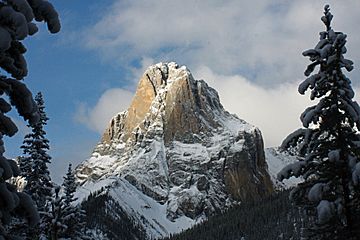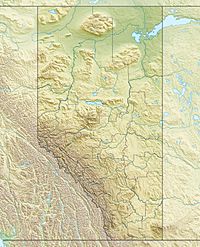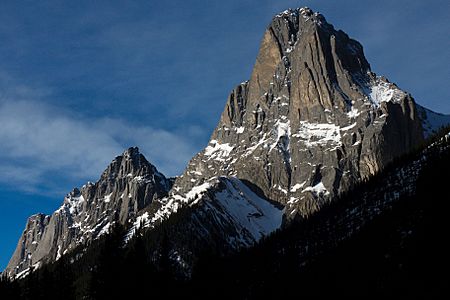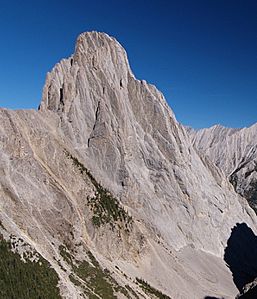Mount Louis facts for kids
Quick facts for kids Mount Louis |
|
|---|---|
 |
|
| Highest point | |
| Elevation | 2,682 m (8,799 ft) |
| Prominence | 336 m (1,102 ft) |
| Parent peak | Mount Cory (2802 m) |
| Listing | Mountains of Alberta |
| Geography | |
| Location | Alberta, Canada |
| Parent range | Sawback Range |
| Topo map | NTS 82O/04 |
| Geology | |
| Age of rock | Devonian |
| Mountain type | Limestone |
| Climbing | |
| First ascent | 1916 by Conrad Kain and Albert H. McCarthy |
| Easiest route | rock climb (YDS 5.6) |
Mount Louis is a tall mountain in Banff National Park, Alberta, Canada. It stands about 2,682 meters (8,799 feet) high. This impressive peak is part of the Sawback Range, which is a group of mountains within the larger Canadian Rockies.
The mountain was named in 1886 after Louis Beaufort Stewart. He was a surveyor who worked in the Banff Park area in 1904. His father, George Stewart, was the very first superintendent of Banff Park.
What is Mount Louis Made Of?
Mount Louis is mostly made of a type of rock called limestone. Limestone is a sedimentary rock. This means it formed over a very long time from tiny bits of material settling at the bottom of ancient seas.
The limestone in Mount Louis was laid down during a time called the Devonian period. This was millions of years ago! Later, huge forces pushed this rock east. This movement, called the Laramide orogeny, made the mountains rise up.
Weather and Climate Around Mount Louis
Mount Louis is in a subarctic climate zone. This means it has very cold, snowy winters. Summers are usually mild and pleasant.
Winter temperatures can drop below -20 °C (which is -4 °F). With the wind, it can feel even colder, sometimes below -30 °C (-22 °F). Summer months are the best time for climbing because the weather is much nicer.
All the rain and melting snow from Mount Louis flows into the Bow River. The Bow River then joins the Saskatchewan River.
Gallery






